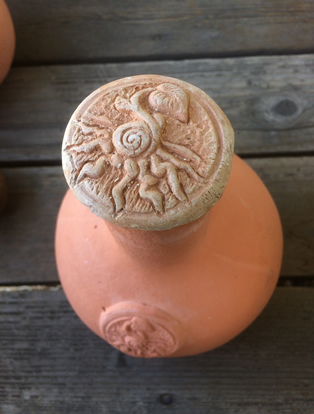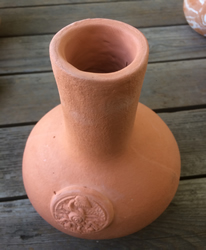The Ollas Project
It's hard to imagine irrigation systems without plastics. Polyvinyl chloride (PVC) is the industry standard material for irrigation pipes, which carry pressurized water to the irrigation zone to be dispersed by sprinklers or a drip system. Drip systems are better for the environment in terms of water conservation, but what about all that plastic? Drip lines/tape wear out fast, but the plastics they are made from persist for thousands of years. It's painful to think that these systems are often replaced annually. But let's back up a little bit here. Surely there was a time, before plastics, when people irrigated and grew crops effectively and efficiently, on a large scale, without creating all this waste? Surely there were people who figured this out? There were, of course. The ancient Romans are still known for having built a massive aqueduct system which "piped" water all over their empire; they also used innovative techniques to water their field crops, including burying unglazed clay "pipes" which tapered at one end and could sleeve into each other, and then wicked water into the surrounding soil. Not long ago in the orange groves of southern California, similar irrigation systems were assembled using terracotta; examples of this can still be seen in some groves in Riverside County. Many modern farmers are taking a fresh look at these old techniques and realizing that they may work as well as, or even better than, our current systems.
Many people report healthier plants using the olla system; after just a few weeks of using ollas in a test garden at Ecology Action, we are already seeing positive results. Overhead watering, especially in excess, can leach nutrients from the soil, particularly minerals such as calcium and magnesium which easily attract to water molecules. The more you water from above and allow gravity to pull the water down, the more nutrition is dragged down out of the root zone. Yellowing plants soon result. With the ollas, not only is it impossible to overwater—as the soil itself decides when it is dry enough to allow water to pass through the pores of the vessel—but since the movement of the water is a slow wicking action moving laterally as well as down, there is no leaching of nutrition from the root zone. We think it possible that using ollas not only can save water, but may reduce the quantity of amendments we need to add to the soil, too. (I would like to find a way to determine what portion of the mineral amendments we add to the soil each season [particularly calcium] is used by the crops, and what portion is lost as ionized particles, dragged to the depths by irrigation water, out of reach of the root zone.) Developing crop-growing techniques for arid land is something we here at Ecology Action are fiercely committed to. With such a large part of the Earth's population already living in arid areas—along with the fact that desertification will only increase that number in the coming years—we are constantly seeking methods and tools to help people living in water-stressed areas to continue to grow food and living soil. The Ollas Project is something that we have been excited about for some time. There is a lot information on ollas online, and several workshops around Mendocino have mentioned the technique and even showed pictures, but we are unaware of anyone locally who had been using ollas regularly to grow crops. So, starting in 2019, Ecology Action teamed up with two local potters, Rain and Maya Youngstrom, as well as several local gardeners, to identify parameters to make the best ollas for our soil and climate. There are many variables: vessel wall thickness, temperature and duration of firing, the content of the clay itself, the shape of the vessel, as well as additives to the terracotta to make the pots wick water faster—sawdust, sand, straw—which will work best?
We are excited to have our first olla prototypes completed by Rain and Maya Ceramics, measured for volume, wall thickness, etc., and in the ground watering squash plants. After we determine best practices, Rain and Maya intend to manufacture the ollas at scale and make them available for purchase; we will update the community when they are available. For now, Rain and Maya sell their beautiful pottery at events like the Kate Wolf Festival, as well as sales at Mendocino College and the Willits Art Center. Some of their finer porcelain can be found at Mariposa Market in Willits, CA. They are a lovely and talented couple, and we are pleased to be working with them on this project. For the next few months, we will be collecting data and testing different olla types and cultivation techniques, to see what works best, with the goal of writing a pamphlet that can be used by people in arid areas to create and use their own irrigation pots. We are excited to share our progress with the GB community, and hope ollas may become a commonly used system in the future. Stay tuned! top | Newsletter Home |Table of Contents| Archive
|



 Many parts of the world still use terracotta vessels, buried in the ground and filled with water, to irrigate their gardens. Called "ollas" (meaning "pots" in Spanish, pronounced "oy-yahs") in some regions, these low-fired, unglazed clay pots with large bulbous bases and tall skinny necks are popular in areas where water is scarce, surface evaporation due to intense sun is relentless, and simply "watering the garden" is viewed (accurately) as a waste of precious water. Ollas slowly leach water through their porous walls and into the surrounding soil, delivering moisture directly to the root zone where it is most needed, saving up to ten times the water compared with traditional surface watering, to grow the same yield.
Many parts of the world still use terracotta vessels, buried in the ground and filled with water, to irrigate their gardens. Called "ollas" (meaning "pots" in Spanish, pronounced "oy-yahs") in some regions, these low-fired, unglazed clay pots with large bulbous bases and tall skinny necks are popular in areas where water is scarce, surface evaporation due to intense sun is relentless, and simply "watering the garden" is viewed (accurately) as a waste of precious water. Ollas slowly leach water through their porous walls and into the surrounding soil, delivering moisture directly to the root zone where it is most needed, saving up to ten times the water compared with traditional surface watering, to grow the same yield.
 Beyond the vessels themselves, there are variables to consider in olla spacing, distance from plants, which crops work best with ollas, and which soil types accommodate ollas and which don't. Melons and fruit trees, which have a single base and root zone for a large yield area, may do well having one to four ollas planted at their base; crops like potatoes and carrots, which have a large, fragmented root zone supplying many plants, may need a different configuration. Which type of crop culture works best with this system?
Beyond the vessels themselves, there are variables to consider in olla spacing, distance from plants, which crops work best with ollas, and which soil types accommodate ollas and which don't. Melons and fruit trees, which have a single base and root zone for a large yield area, may do well having one to four ollas planted at their base; crops like potatoes and carrots, which have a large, fragmented root zone supplying many plants, may need a different configuration. Which type of crop culture works best with this system?
